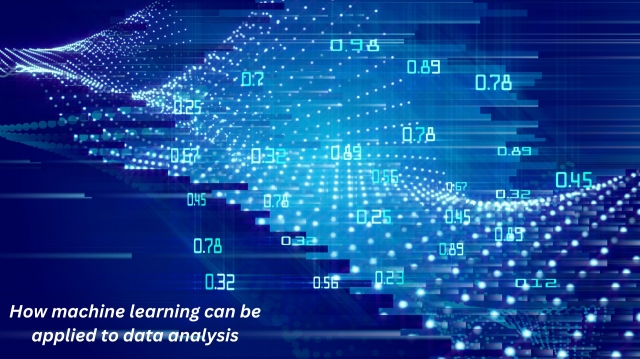Machine learning (ML) is transforming the landscape of data analysis, enabling you to extract meaningful insights from vast datasets with unprecedented efficiency. Leveraging ML enhances data quality, predicts future trends, uncovers hidden patterns, and improves decision-making.
This comprehensive guide explores how to effectively apply machine learning to your data analysis processes.
How Can Machine Learning Improve Data Quality?
Data errors, including outliers, missing values, and duplicates, can significantly hinder analysis. Automated data cleaning uses ML algorithms to identify and correct these errors. Techniques like imputation for missing values, clustering for outlier detection, and deduplication algorithms help maintain a clean dataset, ensuring the reliability of your analysis.
Feature engineering involves creating and selecting the most relevant features from raw data to improve model performance. ML algorithms can automate this process, identifying significant patterns and relationships within the data. This reduces the time and effort required for manual feature selection and enhances the model's predictive power.
Expanding your dataset synthetically improves model performance, particularly when dealing with limited data. Data augmentation techniques generate new data points by applying various transformations to existing data.
How Can You Discover Hidden Patterns in Your Data?
Understanding data analysis is crucial for making informed decisions and driving business success. As data becomes more complex, the ability to interpret and analyze it effectively becomes even more essential. Many data analysts struggle to identify patterns and extract meaningful insights from vast datasets. These issues can be effectively overcome by focusing on data analyst on the job training. By honing these skills, analysts can leverage ML algorithms to uncover hidden patterns and transform data into actionable insights, significantly enhancing their decision-making processes.
Clustering Algorithms
Clustering algorithms, such as k-means, hierarchical clustering, and DBSCAN, group similar data points, uncovering intrinsic data structures. This helps you identify natural groupings within your data, such as customer segments, and tailor your strategies accordingly.
Anomaly Detection
Techniques like Isolation Forest and Autoencoders detect anomalies by identifying unusual patterns that could indicate fraud, errors, or other significant deviations. This is crucial for maintaining data integrity and security.
Association Rule Learning
Algorithms like Apriori and FP-Growth identify relationships between variables in large datasets. This helps you uncover hidden patterns and associations, such as frequently purchased products, enabling you to make data-driven decisions.
Best Ways to Predict Future Trends with ML
Predictive analytics helps forecast future trends, enabling proactive decision-making. ML models excel at identifying patterns and making accurate predictions based on historical data.
For accurate future trend predictions, time series forecasting models are essential. These models analyze temporal data to predict future values based on historical trends, helping you anticipate market changes, demand fluctuations, and more.
Regression analysis, both linear and nonlinear, predicts continuous outcomes. Applying these models helps you understand the relationships between variables and forecast outcomes such as sales, prices, and other key metrics.
For categorical predictions, classification techniques are highly effective. These algorithms categorize data into predefined classes, making them useful for tasks like customer segmentation, fraud detection, and medical diagnosis.
Real-Time Data Processing Benefit Your Business
Real-time data processing allows for immediate analysis and action, ensuring you stay ahead of the curve. ML plays a critical role in enabling this capability.
Frameworks for real-time data ingestion and processing enable data analysis as it is generated, providing timely insights and allowing for immediate action.
Online learning algorithms update models incrementally as new data arrives, keeping them relevant and accurate over time. This is particularly useful for dynamic environments where data continuously evolves.
Edge computing brings ML to the edge, analyzing data closer to where it is generated. This reduces latency and bandwidth usage, providing faster insights and enabling real-time decision-making.
Improving Decision-Making Processes
Enhancing decision-making processes with ML ensures that your strategies are data-driven and effective. ML models provide valuable insights to guide your decisions.
Combining predictive models with optimization algorithms, prescriptive analytics recommend actions based on predicted outcomes. This helps you choose the best course of action to achieve your goals.
Modeling different scenarios and simulating their outcomes with ML allows you to evaluate potential strategies and their impacts. This helps you make informed decisions under uncertainty.
Causal inference techniques identify and quantify causal relationships in data. This provides a deeper understanding of how different factors influence each other, enabling you to make more informed decisions.
How Can You Visualize Data More Effectively with ML?
Effective visualization and interpretation of data ensure that insights are easily understood and actionable. ML enhances these capabilities significantly.
Dimensionality reduction techniques simplify data while preserving its structure. This makes it easier to visualize and interpret large datasets, helping you identify key patterns and insights.
Integrating ML with interactive dashboards creates dynamic and insightful data visualizations. Interactive dashboards allow you to explore data visually, making it easier to understand and communicate findings.
Natural Language Processing (NLP) enables automated report generation and data interpretation. By analyzing text data, NLP algorithms extract meaningful insights and present them in a comprehensible format, enhancing your ability to make data-driven decisions.
Integration with Big Data Technologies
Integrating ML with big data technologies enables the analysis of massive datasets, unlocking new opportunities for insights and innovation.
Applying ML algorithms within a big data ecosystem allows you to analyze massive datasets efficiently. This integration leverages the distributed processing power for scalable ML solutions.
Using ML with NoSQL databases facilitates the analysis of unstructured data. These databases provide flexibility and scalability, making them ideal for handling large volumes of diverse data.
Cloud-based ML services offer scalable ML solutions. These services provide powerful tools and infrastructure for building, training, and deploying ML models, enabling you to leverage the full potential of machine learning.
Ethical Considerations and Best Practices
Addressing ethical considerations ensures that ML applications are fair, transparent, and responsible. Best practices help maintain these standards.
Ensuring that ML models are fair and unbiased is crucial. Techniques like fairness constraints and adversarial debiasing help mitigate bias, promoting equity and inclusion in your analysis.
Implementing privacy-preserving techniques such as differential privacy and federated learning protects sensitive information. This ensures compliance with data privacy regulations and maintains user trust.
Tools for transparency and explainability make ML models interpretable and understandable to stakeholders. Transparency and explainability are essential for building trust and ensuring the responsible use of machine learning.
To effectively integrate machine learning into your data analysis workflows, follow a strategic roadmap. This includes defining clear objectives, selecting appropriate tools and techniques, and continuously evaluating and refining your models. By doing so, you can maximize the impact of machine learning on your data analysis processes.

FAQs
1. How does machine learning improve data quality?
ML automates data cleaning, identifying and correcting errors to ensure reliable analysis.
2. What is the role of clustering in data analysis?
Clustering groups similar data points, helping you uncover intrinsic data structures.
3. How can real-time data processing benefit my business?
It provides timely insights, enabling immediate action based on the latest data.






